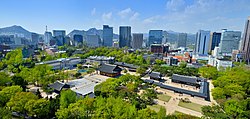Our website is made possible by displaying online advertisements to our visitors.
Please consider supporting us by disabling your ad blocker.
Deoksugung
| Deoksugung | |
|---|---|
덕수궁 | |
 Overview of the palace (2013) | |
 | |
| Former names | Gyeongungung |
| General information | |
| Type | Royal palace (former) |
| Town or city | Seoul |
| Country | South Korea |
| Coordinates | 37°33′58″N 126°58′29″E / 37.56618°N 126.97485°E |
| Korean name | |
| Hangul | 덕수궁 |
| Hanja | 德壽宮 |
| Revised Romanization | Deoksugung |
| McCune–Reischauer | Tŏksugung |
Deoksugung (Korean: 덕수궁; Hanja: 德壽宮), also called Deoksu Palace or Deoksugung Palace, is a former royal palace in Seoul, South Korea. It was the first main palace of the 1897–1910 Korean Empire. It is now a major tourist attraction. It has a mix of traditional Korean and Western architecture that reflects its history.[1] Inside the palace are the Daehan Empire History Museum and National Museum of Modern and Contemporary Art, Deoksugung branch.
The palace was first used as a temporary palace by King Seonjo during the 1592–1598 Imjin War, when the other palaces had been destroyed. In 1611, it was made an official palace named Gyeongungung. The palace then went largely unused until the late 19th century. In 1897, Gojong declared the creation of the Korean Empire and made Gyeongungung the empire's main palace. He attempted to make the palace a symbol of Korea's efforts to modernize. He rapidly expanded it by acquiring land from nearby properties and constructing new buildings in both Korean and Western styles. Under his tenure, the palace's major buildings Junghwajeon and Seokjojeon were constructed. Despite his efforts to keep Korea independent, he was forced to abdicate in 1907 and Korea was colonized by Japan in 1910. He lived in the palace until his death in 1919. After Gojong's death, the colonial government moved quickly to sell off and dismantle the palace's property. By 1930, 18 of the original buildings were left. In 1933, the palace was made a public park. In 1938, a West Wing was constructed for Seokjojeon, and together the two buildings became the Yi Royal Family Art Museum. After these efforts to open the palace to the public, just 8 of the original buildings remained.
Even for decades after the 1945 liberation of Korea, the palace continued to function as a public park, with some public works projects further altering or decreasing the size of the palace. One scholar estimated the palace's current size to be 1/3rd of its peak size. Efforts to restore its pre-colonial appearance began in the 1980s. In 2004, a comprehensive plan to restore aspects of the palace was enacted. As part of this plan, a number of buildings and structures have been recreated or moved back to their original pre-colonial spots based on historical research.
- ^ Kwon, Mee-yoo (2019-10-03). "Architects connect past, future at Deoksu Palace". The Korea Times. Retrieved 2025-01-27.
Previous Page Next Page


